I suffer from the same agonising womb condition as BBC Breakfast host Naga Munchetty – doctors dismissed me too and told me I ‘just need to get on with it’
A mother battling the same painful uterine condition as Naga Munchetty has told how doctors also dismissed her plight and urged her to ‘just get on with it’.
Nikki Allford, 32, has adenomyosis, a little-known condition the endometrium penetrates deep into the muscle wall of her uterus.
Yesterday BBC presenter Munchetty, who has suffered since the age of 15 but was only diagnosed at the age of 47, told MPs she was not taken seriously and urged to ‘suck it up’ for more than 30 years.
Her struggle has sometimes left her screaming in pain, pain so severe that she would lose consciousness.
Ms Allford has suffered similar pain, describing her cramps as ‘so intense they feel like contractions’ and revealing she had to layer sanitary towels on top of each other to cope with her heavy bleeding.
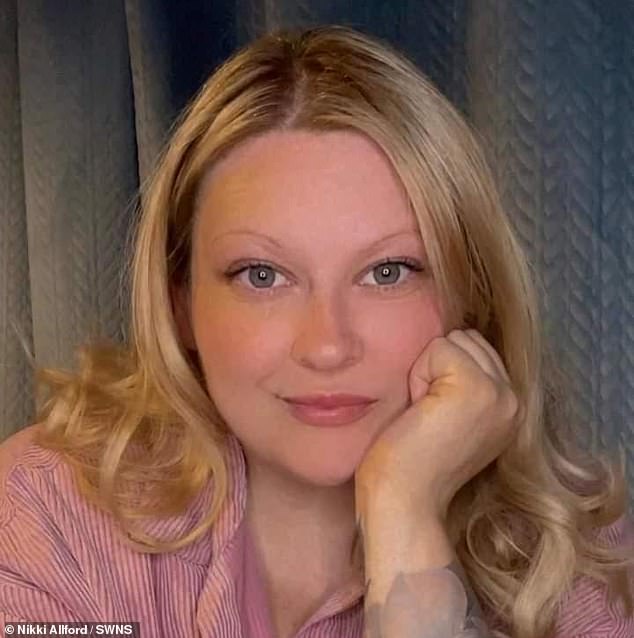
Nikki Allford, 32, has adenomyosis, a little-known condition in which the uterine lining burrows deep into the muscular wall of her uterus
The severity of symptoms varies greatly but often includes heavy periods that last for a long time and severe menstrual pain.
Other women may experience bloating and pain during sex.
Mrs Allford, from Hemel Hempstead in Hertfordshire, has lived with the disorder since she was a teenager, although she was only diagnosed five years ago.
Speaking about her own battle with adenomyosis, the IT worker said: “Since I was 19, I have been going back and forth to doctors with symptoms, having surgery and being in constant pain.
‘Around 2010 I was literally going to the doctor twice a week.
‘I had heavy bleeding and often fell to the ground in pain.’
Ms. Allford remembers a doctor telling her, “You just have to keep going.”
Ultimately, Ms Allford underwent surgery because doctors feared she might have ovarian cancer – a disease that can cause similar symptoms.
Following Ms Munchetty’s appearance before the Women and Equality Committee, Ms Allford said: ‘It was wonderful to see Naga reveal that she too suffers from adenomyosis.
“I hope it gets more people talking about it and more doctors understanding what it means.”
Ms Allford claimed that many healthcare professionals were completely unaware of the disease and others simply ignored it.
She said: ‘I’ve been repeatedly told “do you mean endometriosis?”
‘After I told a woman I was seeing for an appointment that I had adenomyosis, she told me I was mispronouncing endometriosis.
‘I don’t understand why it’s not well known. There are millions of women who suffer from this.’
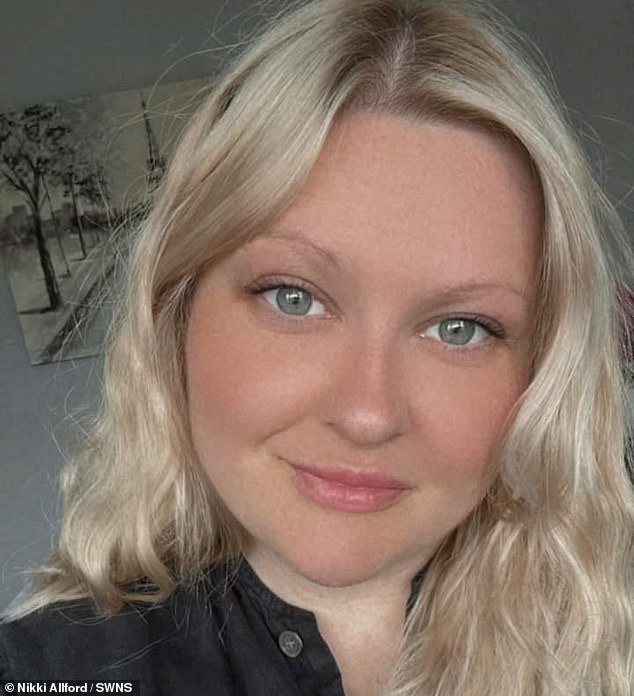
Ms Allford has suffered similar pain, describing her cramps as ‘so intense they feel like contractions’ and revealing she has to layer sanitary pads on top of each other to cope with her heavy bleeding.

Naga Munchetty first revealed she was suffering from the condition in May, when she told her BBC Radio 5 Live show that her husband (pictured in April 2017) was forced to call an ambulance after a flare-up

In some cases, surgery to remove the uterus, a hysterectomy – which Ms Munchetty says she opposes to avoid early menopause – is the only solution for adenomyosis, although this is not suitable for younger women hoping for a natural way to get pregnant.
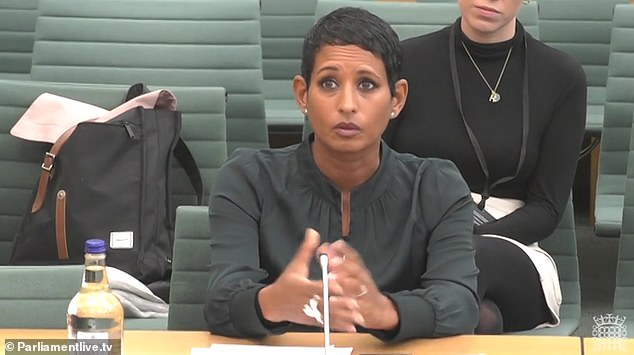
Ms Munchetty, 48, yesterday told how doctors dismissed her symptoms and told her ‘you’re normal’ and ‘everyone goes through this’
During one appointment, Ms. Allford’s doctor said he had never heard of the disease and started Googling it on his computer while she watched.
One way to get rid of the immense pain is to undergo a hysterectomy, which Mrs. Allford has requested time and time again. But doctors simply refuse, she claimed.
She said: ‘I begged a doctor for a hysterectomy when I was 29.
“But they say, ‘What if you want to have more children in the future?’
Mrs Allford, who has three daughters aged 13, eight and five, has had seven miscarriages and does not want any more children.
She said: ‘I already have three beautiful children and I want to enjoy my life with them.’
Charities estimate that around 10 percent of women suffer from adenomyosis, which is similar to endometriosis and can go undiagnosed for years.
It occurs where the lining of the uterus – the endometrium – buries itself into the muscular wall of the uterus. The displaced tissue then continues to function normally – thickening, breaking down and bleeding – during each menstrual cycle.
Ms. Allford says her symptoms peak about three weeks into her menstrual cycle.
She said, “You feel full all the time. You have extreme bloating that is so intense that you look pregnant.
‘I’ve been asked before when I’m pregnant, when I’m actually just having a flare-up.
‘When I get menstrual cramps, they are so intense that they feel like contractions.
“And the bleeding is so heavy that I have to layer sanitary pads on top of each other and then I get clots the size of a golf ball.”
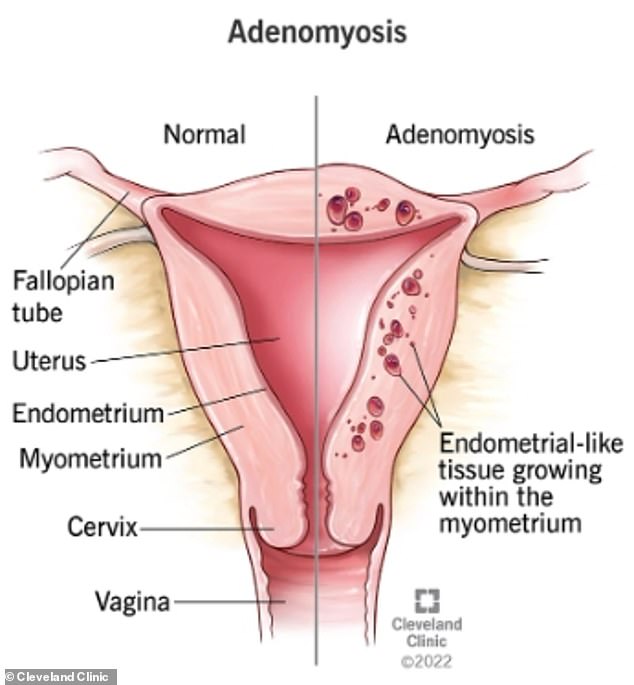
It is not known exactly why adenomyosis occurs. But the NHS notes that it is ‘likely’ that women with adenomyosis ‘have a predisposition due to their genes, immune system and hormones’
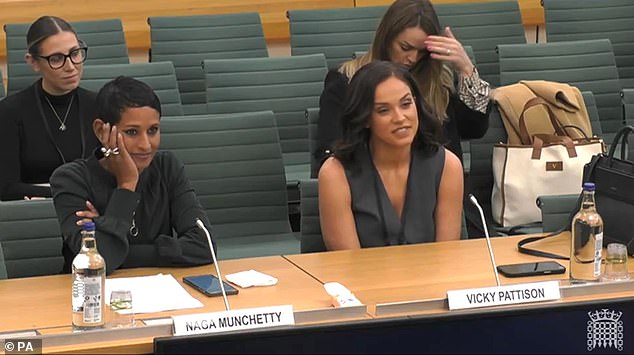
Ms Munchetty addressed the Women and Equality Committee alongside broadcaster and ex-reality TV star Vicky Pattison, who shared her own experiences with premenstrual dysphoric disorder

Vicky Pattison also said doctors made her feel ‘stupid and embarrassed’ and ‘even more disabled’ when she visited them in pain. Her symptoms, which included “crippling anxiety”, insomnia and fatigue, were dismissed as premenstrual syndrome (PMS) by doctors across the country, she claimed. Ms Pattison was pictured with her partner Ercan Ramadan last month
Ms Allford has set up her own support page for other women who also suffer from the poorly understood disease.
She said: ‘I cry about it every day, but I think people are becoming more and more aware of it.’
Ms Munchetty told yesterday how doctors dismissed her symptoms, telling her ‘you’re normal’ and ‘everyone goes through this’.
This was “mainly” among “male physicians who have never had a period and among female physicians who have not had period pain,” she said.
Mrs Munchetty first revealed she was suffering from the condition in May, when she told her BBC Radio 5 Live show that her husband had been forced to call an ambulance after a flare-up. She told how she screamed non-stop for 45 minutes.
Ms Munchetty, 48, also revealed she is opposed to a hysterectomy to avoid early menopause.
She appeared alongside fellow TV star Vicky Pattison in a sensational discussion with MPs on the women’s health issue.
The ex-Geordie Shore star told how she felt ‘dumb and ashamed’ amid her own battle with premenstrual dysphoric disorder (PMDD).
